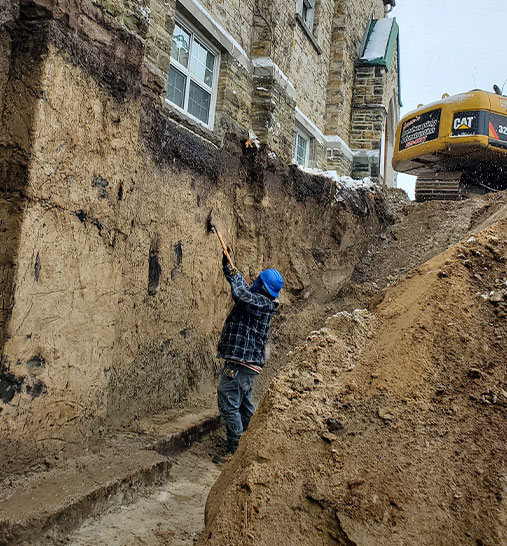Here Are The Best And Most Powerful Foundation Repair Solutions
If your home is affected with a settling foundation, fixing the situation as soon as possible is crucial. The foundation repair method that your property needs depends upon several existing conditions, such as symptoms that your particular property is experiencing, the composition and compaction of the soil below your house, how far down stable conditions are located along with the sort of foundation looking for support.

Most categories of foundation repair don’t qualify as DIY projects and wish the knowledge and tools of an trained professional. However, comprehending the situation and learning the options available are valuable tools when getting a contractor or foundation repair expert.
Identifying Foundation Problems
Foundation problems often show themselves in subtle ways in the beginning. If you notice small cracks within the basement walls or water intrusion after heavy rainfall. Often, those minor issues aren’t greater than annoyances and aren’t symptoms of a tremendous issue. However, just like often, they’re signs and symptoms of bigger problems into the future or else handled immediately. If you notice small signals genuinely, use a professional take a peek to evaluate your situation.
Should you begin to find doors at your residence that will no longer open or close easily, windows which might be tough to operate, gaps developing in trim work or cracks from the drywall, immediate attention is critical to identify and repair what could be an important foundation problem.
Permanent Foundation Repairs
There are many approaches to reestablish support on your home’s foundation. The best option depends upon the soil composition under the house and the that needs repair.
Steel Piers
In most cases, installing steel piers under your property is the most effective long-term solution to stabilize the foundation-It’s the costliest. Just for this repair, galvanized steel posts are determined deep in the ground under the foundation. The piers will go as deep as important to reach bedrock or soil that’s compact enough to supply enough support.
Steel piers can carry massive amounts of weight, be employed in virtually any upper soil condition and are considered a lasting repair.
Helical Piers
Helical piers are another permanent foundation repair method made from galvanized steel. Essentially, they may be steel posts that twist in the ground which has a helically-shaped leading point that resembles a screw or auger and pull the pier deeper below the surface when turned by large machinery.
Helical piers are excellent for supporting the huge weight of a home and foundation and not having to reach bedrock. The devices are drilled into the ground until they reach heavy soil compact enough to aid the load before being permanently connected to the house.
Concrete Piles
Concrete piles are merely blocks or cylinders of pre-cured concrete. They may be several inches long and wide or many feet thick and long. The piles are impelled or placed under the foundation into compacted soil and might include one piece or several stacked in addition to the other.
Concrete piles certainly are a lower-cost replacement for steel piers. However, the soil through your home will determine if they’re an acceptable solution for your foundation.
Poured Concrete Piers
Poured concrete piers are another lower-cost foundation repair solution when the conditions are right beneath your home. The technique contains digging a sizable hole within the foundation, filling it with wet concrete and allowing it to cure before attaching it towards the home.
Poured concrete piers are helpful in lots of soil conditions and may resemble simple cylinders or why not be created with a bell shape in the bottom to offer increased support.
Minor Foundation Adjustments
Sometimes your home can experience foundation conditions aren’t severe enough to warrant a heavy-duty repair however should be dealt with to stop bigger issues.
Slab Jacking
Should your home rests with a concrete slab that is unlevel or that shows cracks from soil erosion, slab jacking may solve the problem. Slab jacking involves drilling holes within an existing slab and injecting a concrete slurry or dense reboundable foam within the failing section.
Slab jacking is a type of solution for sagging sidewalks, driveways and garage floors. Should your home’s slab foundation rests on sufficiently compacted soil, slab jacking can provide an enduring treatment for sagging.
However, slab jacking isn’t a heavy-duty repair method. A complete repair may involve more than one application as soil continues to erode or settle.
Shimming
New homes are sometimes built on ground that won’t are already sufficiently compacted before their foundations were constructed. After the home is complete, that soil can shift or erode, producing gaps relating to the foundation along with the remaining portion of the home’s structure. The trouble might or might not be indicative of more problems.
After an inspection with the situation, your foundation expert or structural engineer may decide that filling the visible difference with steel shims is adequate for reestablishing proper support. Shims perform as a permanent solution if your soil stops settling underneath the home. However, if gaps reappear, a more invasive repair likely needs to happen.
Check out about EC Foundations see our new web portal

Leave a Reply
You must be logged in to post a comment.